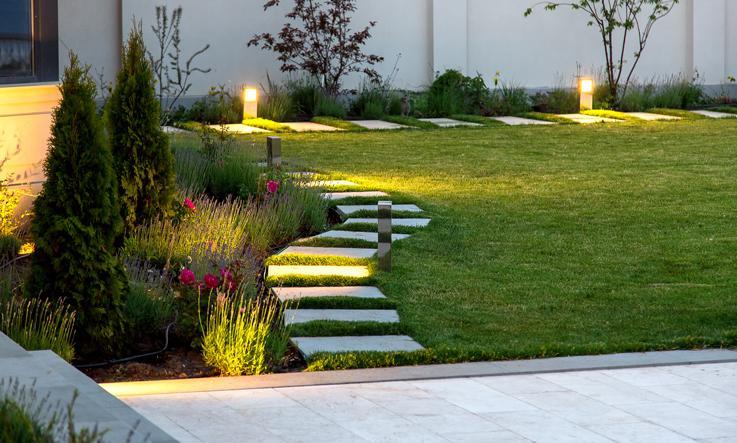
Furnishing gardens and balconies with outdoor tiles
Those who are lucky enough to be able to enjoy a garden where they can spend pleasant hours immersed in nature, will sooner or later have to deal with paving an area where they can place chairs, tables and all those furnishing elements that are needed to make their green corner special. Even if the idea of creating a relaxation space on an uncoated ground is bucolic and "green", it comes up against a series of cons, such as dust, weeds, accumulations of humidity and instability of the installations, as well as with an unpleasant aesthetic effect.
If your idea is to create an outdoor lounge or a more convivial area in which you can invite friends with whom to share pleasant summer evenings and barbecue parties, you are meant to create a permanently paved lawn area.
The most important requirement: anti-slip
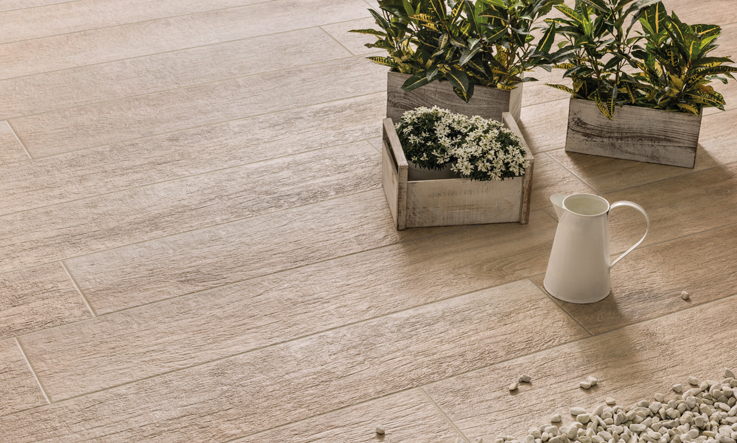
We have already discussed about the characteristics and types of outdoor floors in another article, here we only limit ourselves to recap the main ones. First of all, the surface must be strictly non-slip and here it is worth making a small digression on the different classifications. To date, there is no common European standard for measuring the slipperiness of a tile and each country adopts its own measurement method.
The Italian policy DM 236/89 uses the English method known as BCR tortus, but there is also an American and a German method, just to mention the most common ones. So how do you determine if a tile can also be installed outdoors? By convention in Italy the German method is used, which consists of a person walking back and forth on a platform which is covered with the material to be tested with variable inclinations. The inclination of the test platform is increased up to the angle at which the person starts to slide. The method refers to DIN 51.130 and 51.097 and consists of a classification with values ranging from R9 to R13.
To be on the safe side, a good outdoor flooring must have at least a R11 value, in order to guarantee good performance even in wet conditions. If you want to install tiles in particularly humid areas, such as the edges of a swimming pool, you have to choose R12 outdoor tiles.
A choice for each area
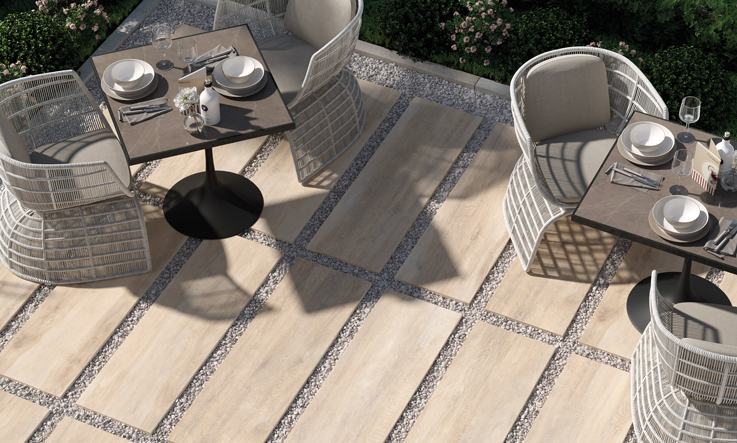
Now we have to talk about the different areas in which it is possible to install porcelain stoneware slabs for outdoors. Paths and walkways lend themselves both to traditional installations glued on screed and to more creative solutions that can be directly installed on gravel, sand or grass. In the second case, high-thickness stoneware slabs are particularly indicated, because thanks to the weight of the slab itself they do not move, and you don’t have to use any kind of adhesives.
If you opt for paths with gravel, you can think of positioning the slabs at a distance of 5/10 cm from each other and fill these spaces with white, gray or black decorative stones, in order to obtain a very natural but at the same time elegant effect. For entrance paths, installing on grass is not recommended, as keeping the area between one slab and another clean may be difficult. High-thickness stoneware slabs are also indicated for the perimeter walkways of the building, especially if the house is subjected to important subsidence and settling phases. If you install standard thickness outdoor tiles, in fact, the movement of the ground under the house can cause detachments and breakages even if the tiles have been installed by a professional.
For the relaxation or the barbecue area, different solutions can be adopted according to the tastes and the outdoor furniture. For the naturally harmonious installation on grass, you have to respect some precautions. First of all, the surface must be perfectly flat, therefore it could be necessary to fix excessive bumps and slopes before installation. In addition, the slab must not be simply supported, but a hollow of a few centimetres of the same size as the slab must be created, in which the slab will then be placed. This operation has two advantages, keeping the tile more stable over time and allowing the grass mowers to pass over the tiles without damaging the blades.
This is a solution which, although lends itself also to the barbecue area, can have some contraindications, especially if there is a lot of space between one stoneware slab and the other. In this case, it would be better to include a small concrete casting that must then be covered with normal thickness outdoor tiles, on which you can place gazebos, tables and chairs.
As for porches and balconies, the most relevant factor is their exposure to external agents. In particularly for sheltered or small-sized porches, an R10 outdoor tile is perhaps the best solution in terms of balance between slip resistance and ease of cleaning, not forgetting the chromatic continuity with the rest of the house floors. For small or medium-sized balconies and terraces, small-sized stoneware tiles for outdoors can also be used. If we want to cover bigger areas, it is preferable to opt for medium-large tiles.
So many effects to choose from
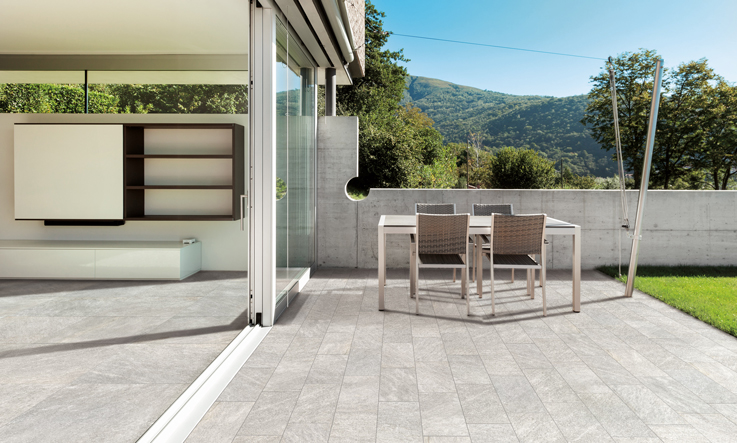
From an aesthetic point of view, when choosing an outdoor flooring you have to choose a type of tile that harmonizes with the surrounding environment. Moreover, there is the increasingly widespread trend of using the same collection both for indoor and outdoor areas.
Stone effect represents the most popular choice when it comes to outdoor flooring and the wide range of available products is the proof of the success of these garden tiles. Stone effect porcelain stoneware floors take on the appearance of rocks that have always been used to furnish the outdoors. Slate, quartzite, gneiss, calcarenite, up to the most sought-after local stones such as Vals, Varana, Panama, there is really spoiled for choice for these frost-proof and waterproof stoneware reproductions.
Alongside stone, concrete and wood effects are also widespread. The first is the perfect complement for modern villas and gardens, going back to the most contemporary architectural styles both in appearance and in the neatness of shapes and graphics. Wood effect porcelain stoneware for outdoors, on the other hand, adds a touch of rusticity and naturalness, taking up typically Alpine and northern European flooring styles, without sacrificing the comfort of porcelain stoneware.
The right color
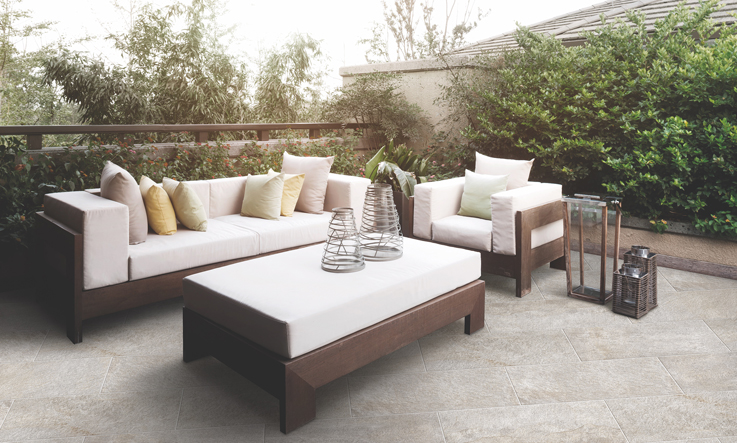
The selection of colors is fundamental when it comes to the choice of outdoor. As previously seen, the trend is to use the same products for indoor and outdoor areas, especially for areas such as balconies, verandas or dehors. For gardens, however, the brick colors of the house are often an important influence. As for colors, it is advisable to choose natural colors in shades of sand, beige, gray or brown. You can also dare with brighter colors, but the risk is that there will be a too vivid contrast under the sunlight. Those who prefer comfort, should not opt for too light colors, but to choose medium-dark tones that allow you to mask the dirt, and will not require you to continuously clean the outdoor areas.